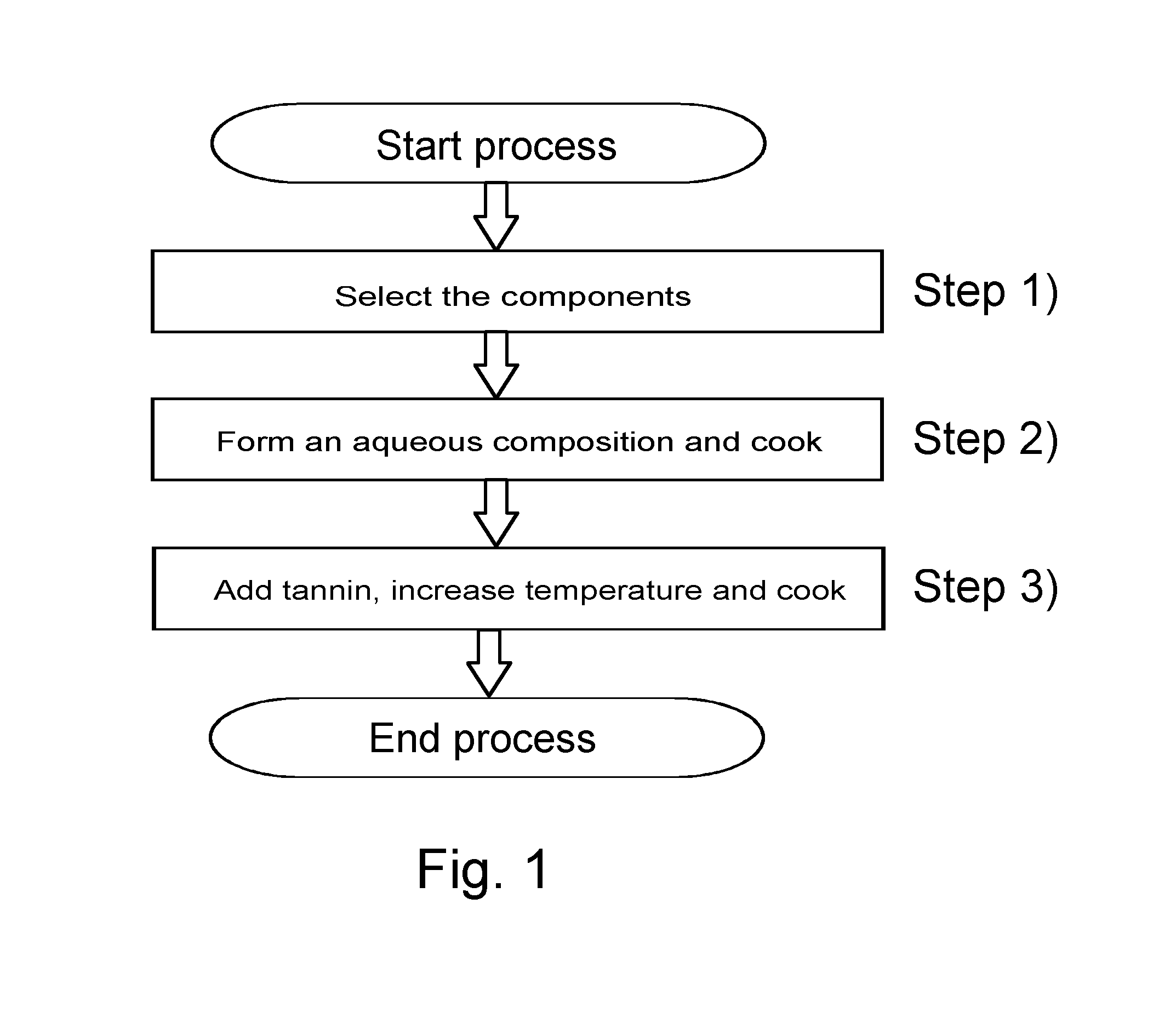Method for producing a binder composition, a binder composition, an adhesive composition, a layered composite structure, and uses of the binder composition and the adhesive composition
- Summary
- Abstract
- Description
- Claims
- Application Information
AI Technical Summary
Benefits of technology
Problems solved by technology
Method used
Image
Examples
example 1
Preparing a binder composition
[0085]In this example a lignin-tannin-phenol formaldehyde binder composition was produced according to the embodiment of the present invention shown in FIG. 1.
[0086]The following components and their amounts were used:
water300 gNaOH (first part (dispersion)) 50%250 gkraft lignin 98%400 gtannin 90%150 gphenol 90%250 gformaldehyde 38%1000gNaOH (second part (catalyst)) 50%100 g.
[0087]The percentage of the components (based on dry contents) used in this example was the following:
NaOHabout 13%kraft ligninabout 30%tanninabout 10%phenolabout 17%formaldehydeabout 30%.
[0088]Firstly, water, the first part of NaOH and lignin were mixed such that dispersion was formed. Simultaneously the temperature increased from room temperature to about 65° C. Then all of the phenol was added followed by adding the formaldehyde in a stepwise manner for forming an aqueous composition. The temperature was kept under 65° C. After adding also the second part of the NaOH to the compo...
example 2
Preparing a Binder Composition
[0091]In this example a lignin-tannin-phenol glyoxal binder composition was produced.
[0092]The following components and their amounts were used:
water370 gNaOH (first part (dispersion)) 50% 300 gkraft lignin 75%530 gtannin 90%100 gphenol 90%540 gglyoxal 40%1100 gNaOH (second part (catalyst)) 50%150 g
[0093]Firstly, water, the first part of NaOH and lignin were mixed such that dispersion was formed.
[0094]Simultaneously the temperature increased from room temperature to about 50° C. Then all of the phenol was added followed by adding the glyoxal in a stepwise manner for forming an aqueous composition. The temperature was kept under 65° C. ¾ of the total amount of tannin was added to the above formed aqueous composition when at least half of the amount of glyoxal, preferably all of the amount of glyoxal, had been added to the composition. After adding also the second part of the NaOH to the composition, the composition was cooked until the viscosity of the c...
example 3
Preparing a Binder Composition
[0095]In this example a lignin-tannin-resorcinol formaldehyde binder composition was produced.
[0096]The following components and their amounts were used:
water340 gNaOH (first part (dispersion)) 50% 240 gkraft lignin 75%494 gtannin 90% 21 gresorcinol 90%450 gformaldehyde 40%800 gNaOH (second part (catalyst)) 50%115 g
[0097]Firstly, water, the first part of NaOH and lignin were mixed such that dispersion was formed. Simultaneously the temperature increased from room temperature to about 50° C. Then half of the resorcinol was added followed by formaldehyde in a stepwise manner for forming an aqueous composition. The temperature was kept under 65° C. Rest of the resorcinol was added to the above formed aqueous composition when at least half of the amount of formaldehyde, preferably all of the formaldehyde, had been added to the composition. After adding also the second part of the NaOH to the composition, the composition was cooked until the viscosity of the...
PUM
| Property | Measurement | Unit |
|---|---|---|
| Temperature | aaaaa | aaaaa |
| Temperature | aaaaa | aaaaa |
| Temperature | aaaaa | aaaaa |
Abstract
Description
Claims
Application Information
 Login to View More
Login to View More - R&D
- Intellectual Property
- Life Sciences
- Materials
- Tech Scout
- Unparalleled Data Quality
- Higher Quality Content
- 60% Fewer Hallucinations
Browse by: Latest US Patents, China's latest patents, Technical Efficacy Thesaurus, Application Domain, Technology Topic, Popular Technical Reports.
© 2025 PatSnap. All rights reserved.Legal|Privacy policy|Modern Slavery Act Transparency Statement|Sitemap|About US| Contact US: help@patsnap.com


